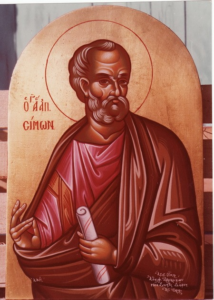Apostle St. Simon, The Zealot – May 10

Simon the Zealot is one of the most obscure among the apostles of Jesus, a man about whom we know so little, to add to the fact that, his name also produces problem. The name occurs in all four lists of Apostles. To distinguish him from Simon Peter, he is called as Simon the Canaanite (Kananaios) in Matt. 10: 4 and Mk. 3: 18 and as Simon the Zealot (Zelotes) in Lk. 6: 15 and Acts 1: 13. The reading of the best and the most ancient manuscript is Kananaios, and not Kananites. So, Simon’s descriptive title should be Cananean. The Aramaic word for Cananean is Zealots. This word is derived from the Hebrew verb qana or kana, which means zealous, and it was used for those who had a zeal for the Law. The word Zelotes is precisely the same word in Greek. Thus, he had the zeal for the sanctity and honour of the Jewish Law, before his call to the Apostolate. The Zealots were wild and fanatical nationalists pledged to harry the Romans by any means, even murder or assassination. Simon may have been called the Zealot because of his great and burning zeal for the Savior and His Gospel (Lk. 6: 15).
Tradition says that he was the bridegroom at the wedding where the Savior performed His first miracle. He was known to the Lord and His Mother. After witnessing the miracle of the water which had been turned into wine, he became a zealous follower of Christ. Shortly after this and because of this miracle, St. Simon left his home, parents and bride to follow Christ. For this reason, he is known as Saint Simon the Zealot. So, Either “Zealot” is about the apostle’s passionate faith, or his membership in a New Testament group called the “Zealots,” or both.

In an apocryphal a narration, related to this apostle is mentioned, as a boy named Simon is bitten by a snake in his hand; he is healed by Jesus, who told the child “you shall be my disciple“. The mention ends with the phrase “this is Simon the Cananean, of whom mention is made in the Gospel. Many wrongly assume that Kana was his native place. If it was so, he should be called Kanaios. So, the word Kananaios does not describe Simon’s nationality, but describes his political party. Simon was not a Canaanite foreigner; he was a fanatical Jewish nationalist. Apart from being mentioned in the lists, Simon is not mentioned at all during Jesus’ mission on earth. However, his name being in the list Acts shows that he was committed along with other disciples to spreading the message of Jesus.
After receiving the Holy Spirit, at Pentecost, not much is known of Simon’s activities. Some say he went off to preach the Gospel in Mauritania in Africa. Other traditions say Apostle had preached in Edessa, Egypt, Libya & following the Apocryphal Passion of Simon and Jude, also believed to have preached with St. Jude in Persia, where they were both martyred. Even the legend is vague about him. Simon and Jude traveled throughout the country. They eventually made around 60,000 new Christians during their fifteen-month stay in the region. They eventually came to Suanir. Here they drove the demons out of the idol Gods. The Pagan priests rushed the disciples and killed them. At this time, a calm and serene sky suddenly became so full of lightning that the temple was split into three segments. The king of the country rescued the bodies of the disciples and built a Church their honour. Simon left everything in his previous life to follow Jesus. He lived true to the Great Commission after Jesus’ ascension.

For his success in bringing many to the Faith of Christ, it is believed that he was tortured and he was sawed into two for the Lord, who had prepared a crown of glory for him in His immortal Kingdom. The relics of Simon and Jude were supposedly translated to St. Peter’s in Rome around the eighth century. There are a few ancient churches dedicated to St. Simon and St. Jude, but none for either alone. Concerning his relics our information is as uncertain as his preaching. His feast day is kept as May 10th and October 28th in the Western Churches
0 Comments